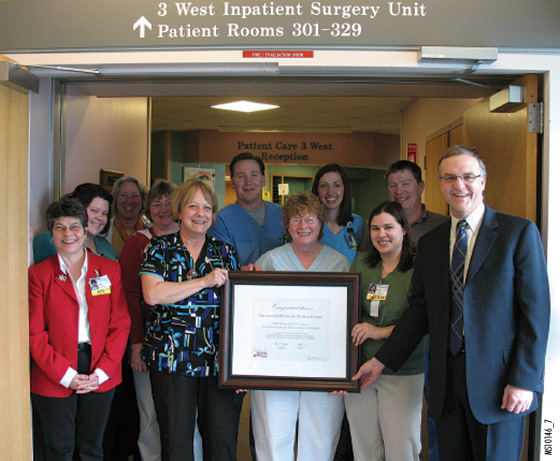Dartmouth-Hitchcock Medical Center (DHMC) of Lebanon, New Hampshire, was selected as the winner of the 4th Health Devices Achievement Award, announced in September 2009, for its efforts to reduce failure-to-rescue events through a new application of pulse oximetry monitoring: using it continuously from admission to discharge.
The Health Devices Achievement Award recognizes outstanding initiatives undertaken by member healthcare institutions to improve patient safety, reduce costs, or otherwise facilitate better strategic management of health technology.
Discussion
Dartmouth-Hitchcock's work was designed to reduce failure-to-rescue (FTR) events—incidents in which a patient's condition goes into critical decline unbeknownst to clinicians, and last-minute interventions fail to keep the patient alive. In the majority of cases, such "drift" in a patient's condition is associated with respiratory issues.
 ECRI Institute's Jim Keller poses with staff members on the ward where Dartmouth-Hitchcock Medical Center's monitoring project was carried out. The team that spearheaded the project received a standing ovation during the presentation of the Health Devices Achievement Award at a ceremony at DHMC on March 18, 2010.
ECRI Institute's Jim Keller poses with staff members on the ward where Dartmouth-Hitchcock Medical Center's monitoring project was carried out. The team that spearheaded the project received a standing ovation during the presentation of the Health Devices Achievement Award at a ceremony at DHMC on March 18, 2010.
|
Keeping patient deterioration from being missed is critically dependent on effective surveillance. That, in turn, relies on finding the right mix of specificity and sensitivity. Making the best use of available nursing resources, while finding an effective compromise between too few and too many alarms and nursing notifications, is key to reducing FTR events.
DHMC's project evaluated the use of pulse oximetry for continuous monitoring in the postoperative care setting, from after surgery to discharge. Monitoring patients continuously allows nurses to better detect a downward trend in a patient's condition and therefore to intervene before the patient deteriorates to the point of requiring a rescue team. Monitoring at the bedside was used whenever patients were not in direct contact with a caregiver, and all signals were wirelessly transmitted to a central workstation. The patient's nurse was notified directly by wireless pager any time static alarm limits were exceeded.
A secondary goal of the project was to reduce nuisance alarms—a combination of false-positive and nonactionable alarms. Accomplishing this goal was a considerable challenge, since pulse oximetry is highly susceptible to motion artifact. The result can be numerous nuisance alarms, which not only waste nurses' time but can also desensitize them to alarms. The DHMC team tackled this problem through close attention to probe selection, probe placement guidelines, and alarm parameters, all of which were individualized to each patient. In addition, they established a 15-second delay before alarms sounded at the bedside, followed by another 15-second delay before the system paged a nurse.
The findings from this study were that rescue events were reduced from 3.4 to 1.2 per 1,000 patient discharges, and transfers to the intensive care unit dropped from 5.6 to 2.9 per 1,000 patient-days.
Nurses have been very satisfied with the system. Alarms have been reduced to an average of two per shift, with some shifts experiencing no alarms at all. And the continuous nature of the monitoring has allowed nurses to detect drift earlier and intervene sooner. As a result, interventions by the rescue team have been reduced, and those interventions that have been needed are often more orderly.
When announcing the award in September 2009, James P. Keller, Jr., ECRI Institute's vice president for health technology evaluation and safety, remarked: "ECRI Institute has identified clinical alarm hazards as the number one device-related risk on its list of top 10 health technology hazards. Thus, any effort to improve this problem can have a huge impact on patient safety." Keller added that "Dartmouth-Hitchcock Medical Center should be commended for recognizing the problems that alarm 'overload' can cause and for taking on a project to improve the way clinicians monitor for and respond to serious changes in patient conditions."
George Blike, MD, quality and patient safety officer for Dartmouth-Hitchcock Medical Center, said, "The award from ECRI Institute is a tremendous honor and a great recognition for the many people who have played a role in the deployment of this new technology." He added, "Creating excellence in patient care is a matter of finding and training the right people, enabling them with the right tools, and doing it all within the right environment of care. This tremendous group effort and innovative technology have combined to save lives, which is incredibly rewarding for everyone involved."
The work on patient monitoring that led to DHMC receiving the Health Devices Achievement Award is also highlighted in two articles published in the February 2010 issue of
Anesthesiology.